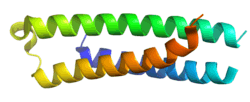STX10
| Syntaxin 10 | |||||||||||||
|---|---|---|---|---|---|---|---|---|---|---|---|---|---|
|
syntaxin 10, N-terminal syntaxin domain. PDB 4DND | |||||||||||||
| |||||||||||||
| Identifiers | |||||||||||||
| Symbols | STX10 ; SYN10; hsyn10 | ||||||||||||
| External IDs | OMIM: 603765 HomoloGene: 84379 GeneCards: STX10 Gene | ||||||||||||
| |||||||||||||
| Orthologs | |||||||||||||
| Species | Human | Mouse | |||||||||||
| Entrez | 8677 | n/a | |||||||||||
| Ensembl | ENSG00000104915 | n/a | |||||||||||
| UniProt | O60499 | n/a | |||||||||||
| RefSeq (mRNA) | NM_001271609 | n/a | |||||||||||
| RefSeq (protein) | NP_001258538 | n/a | |||||||||||
| Location (UCSC) |
Chr 19: 13.14 – 13.15 Mb | n/a | |||||||||||
| PubMed search | n/a | ||||||||||||
Syntaxin-10 (STX10) is a SNARE protein that is encoded by the STX10 gene.[1] This protein is found in most vertebrates (including humans) but is noticeably absent from mice.[2][3] As with other SNARE proteins, STX10 facilitates vesicle fusion and thus is important for intracellular trafficking of proteins and other cellular components. More specifically, STX10 has been implicated in endosome to Golgi trafficking of the mannose 6-phosphate receptor[2] and glucose transporter type 4.[3]
STX10 has been detected in the trans-Golgi network (TGN) by immunofluorescence.[1]
Structure and function
Human STX10 is a 249 amino acid protein that has three N-terminal α-helices and a single SNARE domain followed by a single-pass transmembrane domain. Human STX10 is 60% identical to human STX6.[1]
STX10 is structurally classified as a Qc-SNARE (contributes a glutamine (Q) residue in the formation of the assembled core SNARE complex) and is functionally classified as a t-SNARE (or target-SNARE which is often located in the membranes of target compartments).[4]
Interactions
STX10 is known to interact with the t-SNAREs VTI1A and STX16[5] and with the v-SNAREs VAMP3[2] and VAMP4.[5] The SNARE complex of STX10, STX16, VTI1A, and VAMP3 are required for late endosome to Golgi trafficking of the mannose 6-phosphate receptor.[2] Early endosome to Golgi trafficking of Shiga toxin requires the SNARE complex of STX6, STX16, VTI1A, and VAMP3 or VAMP4.[6]
Thus, STX10 distinguishes early endosome to Golgi trafficking from late endosome to Golgi trafficking.[2]
References
- 1 2 3 Tang BL, Low DY, Tan AE, Hong W (January 1998). "Syntaxin 10: a member of the syntaxin family localized to the trans-Golgi network". Biochem. Biophys. Res. Commun. 242 (2): 345–50. doi:10.1006/bbrc.1997.7966. PMID 9446797.
- 1 2 3 4 5 Ganley IG, Espinosa E, Pfeffer SR. (Jan 2008). "A syntaxin 10-SNARE complex distinguishes two distinct transport routes from endosomes to the trans-Golgi in human cells.". J. Cell Biol. 180 (1): 159–72. doi:10.1083/jcb.200707136. PMC 2213607. PMID 18195106.
- 1 2 Esk C, Chen CY, Johannes L, Brodsky FM. (Jan 2010). "The clathrin heavy chain isoform CHC22 functions in a novel endosomal sorting step.". J Cell Biol. 188 (1): 131–44. doi:10.1083/jcb.200908057. PMC 2812854. PMID 20065094.
- ↑ Hong W. (Jul 2005). "SNAREs and traffic". Biochim Biophys Acta 1744 (2): 120–44. doi:10.1016/j.bbamcr.2005.03.014. PMID 16038056.
- 1 2 Wang Y, Tai G, Lu L, Johannes L, Hong W, Tang BL (Jul–Aug 2005). "Trans-Golgi network syntaxin 10 functions distinctly from syntaxins 6 and 16.". Mol Membr Biol. 22 (4): 313–325. doi:10.1080/09687860500143829. PMID 16154903.
- ↑ Mallard F, Tang BL, Galli T, Tenza D, Saint-Pol A, Yue X, Antony C, Hong W, Goud B, Johannes L. (Feb 2002). "Early/recycling endosomes-to-TGN transport involves two SNARE complexes and a Rab6 isoform.". J. Cell Biol. 156 (4): 653–664. doi:10.1083/jcb.200110081. PMC 2174079. PMID 11839770.
